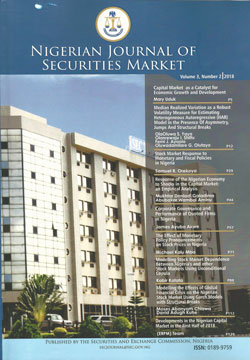
Capital Market as a Catalyst for Economic Growth and Development – Mary Uduk
Median Realized Variation as a Robust Volatility Measure for Estimating Heterogeneous Autoregressive (HAR) Model in the Presence of Asymmetry Breaks – OlaOluwa S. Yaya, Olanrewaju I. Shittu, Femi J. Ayoola, Oluwamilare G. Olutayo
This paper investigated the performance of realized volatility measures for jumps on variants of HAR model which included the newly proposed HAR model with asymmetry, jumps, structural breaks and GARCH errors. Using simulated stochastic diffusion process the results presence of realized volatility estimators that are robust to jumps, such as the Bi-power variation (BV), minimum realized variation (minRV) and medium realized variation (medRV). The results also showed that medRV is the best volatility measure for heterogeneous market models such as the types considered in this work. This work has further represented medRVt as appealing jump-robust estimator of the integrated variance process for intraday (tick-by-tick) financial returns with jumps.
Stock Market Response to Monetary and Fiscal Policies in Nigeria – Samuel R.Orekoya
Unlike most studies that examined the stock market response to variations in monetary policy and fiscal policy in isolation, this study analyzes Nigeria’s stock market response to the joint interactions between fiscal and monetary policies. Employing the SVAR model on quarterly data from 1990Q1 to 2016Q4, the accumulated impulse response shows that both fiscal and monetary policies influence the stock market in Nigeria. Evidence also shows that the interaction between the two policies is very important in explaining the developments in the stock market. Business analysts and investors reviewing the stock market performance in relation to macroeconomic policies are therefore advised to consider the joint, not separate effects of fiscal and monetary policies on the stock market.
Response of the Nigerian Economy to Shocks in the Capital Market: An Empirical Analysis – Mukhtar Danladi Gaaladima and Abubakar Wambai Aminu
This paper undertakes an empirical examination of the response of Nigerian economy to capital market shocks from 1981 to 2016. Using proxies for capital market size as well as a proxy for economic growth, the paper adopts vector error correction model (VECM) through the analysis of impulse response functions (IRFs) and variance decompositions (VDCs). Barring one exception, the IRFs results revealed a positive response of the economy to capital shocks. While two capital market variables ( )tended to significantly cause positive changes to the Nigerian economy, shocks to one other variable tended to generate negative macroeconomic response. The results of the VDCs revealed that the variations in macroeconomic growth were attributable to own shocks as well as shocks arising from three capital market variables. The implication of the results is that MCAP and ND are the key variables of the Nigerian stock market that have greater effect/ influence on Nigerian economy whereas VLT and LEGS have no effect on it. These results argue persuasively on the need to develop the capital market as a complement to economic growth and sustainable development in Nigeria.
Corporate Governance and Performance of Quoted Firms in Nigeria – James Ayuba Akwe
This study set out to examine the relationship between corporate governance mechanisms and performance of consumer goods companies quoted on floor of the Nigerian Stock Exchange (NSE). This is because most studies focused on financial services sector, and limited empirical works among the variables, particularly with regards to quoted consumer goods companies in Nigeria. Hence, the study investigated the relationship between dependent variable as proxied by return on assets and the independent variables as proxied by board size and board composition of quoted consumer goods companies in Nigeria from 2007 – 2016. The population comprises of all quoted manufacturing goods sector quoted on the NSE, out of which seventeen (17) quoted consumer goods companies represent the sample of the study. The study used census sampling technique. The ex-post facto research design was adopted by the study. The study used secondary data obtained from the audited accounts of the sampled firms. Analysis of data was carried out using pooled ordinary lease square, as well as fixed effects and random effects estimators. The findings revealed that both board size and board composition have positive relationship with return on assets. The study recommends that companies should increase the size of their boards not beyond fifteen in line with partial derivatives taken and solved for the optimal values. Also, companies may increase outside directors on its board. This has the capacity to increase economic value and enhance transparency.
The effects of Monetary Policy Pronouncements on Stock Prices in Nigeria – Michael Kalu Mba
Researchers have severally studied the impact of monetary policy on stock market activities (returns and prices). However, following the practice of communicating current and future direction of monetary policy by most central banks, the attention of scholars has shifted to studying the effect of these communications. This paper adopts a different approach by applying the paired sample t-test to evaluate the effect of the MPC pronouncement on stock market prices in Nigeria. The analysis showed that only the stock prices of banks, insurance, and other financial institutions respond to the MPC communications. The results further indicate that stock prices of most quoted firms inch up immediately after the MPC meetings. These findings are relevant to the policymakers based on the need for more information on the future leanings of policy thrust in Nigeria.
Modelling Stock Market Dependence Between Nigeria and other Stock Markets using Unconditional Copula – Kabir Katata
In this paper, we use copula approach to examine Nigerian stock market’s dependence structures with the markets of South Africa, Egypt, Argentina, Indonesia, Mexico, Turkey, Hong Kong, United Kingdom and 2 United States indices. The stock indices were selected as the largest economies in Africa, the top performing indices of 2017 as well as to understand the relationship between developed and developing markets. We examine the marginals using ARMA GJR-GARCH with Normal and t error distributions, while Gumbel, Clayton, Rotated Gumbel, Rotated Clayton, Frank, student t and symmetrized Joe–Clayton copulas with Gaussian as the benchmark are employed to analyze the joint distributions. To help us select the best copula, we perform a range of goodness-of-fit tests on daily returns from 4th January 2007 to 29th December, 2017 of these markets. Our study is limited to pairwise dependence between Nigerian against each of the indices. The Student t copula was found to fit the data very well and emerged as the model to describe pair wise dependence between Nigerian stock index against nine other world’s stock markets. The study also revealed that the Indonesian stock market is the most integrated index with Nigerian stock market. The findings of the study have important implications for portfolio analysis by market players, the choice of which stock market the NSE selects for a deepened relationship as well as for contagion analysis.
Modelling the Effects of Global Financial Crisis on the Nigerian Stock Market using GARCH Models with Structural Breaks -Moses Abanyam Chiawa and David Adugh Kuhe
In financial risk management and portfolio selection, volatility modeling is important because it improves the efficiency in parameter estimation and the accuracy in interval forecast. However, the accuracy is compromised when structural breaks are ignored. This study examined the behaviour of stock returns in Nigerian stock market in the context of Global Financial Crisis. Data on daily closing all share index for the period of 2nd January 1998 to 9th January 2018 are studied using symmetric and asymmetric GARCH-type models. The data was divided into three sub-periods of pre-crisis period, crisis period and post-crisis period to investigate the behaviour of Nigerian stock market in different sub-periods. The study showed the presence of autoregressive conditional heteroskedasticity (ARCH) effect, volatility clustering, leptokurtosis, high shock persistence and asymmetry across the study periods. Volatility was found to increase during the Global Financial Crisis period of 2007-2009 with evidence of asymmetry without leverage effect. The post crisis period showed less persistence to volatility shocks, presence of asymmetry with leverage effects and faster reactions of volatility to market changes. The impact of market shocks caused by the global financial crisis was found to have negative and significant effect on Nigerian stock market. This study also found significant positive risk-return relationship indicating that investors in Nigerian stock market should be compensated heavily for holding risky assets. The study recommends estimation of volatility in the Nigerian stock market to incorporate structural breaks in the conditional variance to avoid over-estimation of market shocks and restore investor’s confidence.
Update on the activities of the Commission
